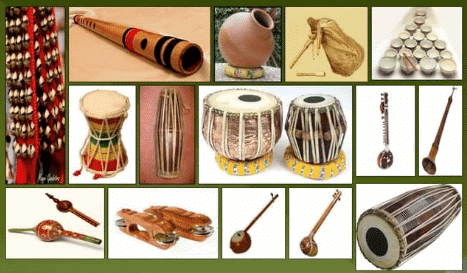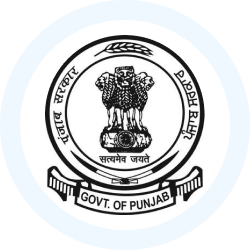Musical Instruments of Punjab | Punjab State (PPSC) PSC: Preparation - PPSC PCS (Punjab) PDF Download
Introduction
Punjab has a long-standing and vibrant musical tradition, with folk instruments that date back many centuries. These instruments have played a significant role in the history of Punjab.
Music is an integral part of almost every occasion and festival in Punjab, and folk dances are typically performed to the tunes of these musical instruments.

Dhol
The dhol is a beloved folk instrument in Punjab, known for its role in various social and festive occasions.
- Type: The dhol is a percussion instrument, a barrel-shaped wooden drum with a skin mounted on both ends.
- Drummer: The person playing the dhol is called a Dholi or Bharaj.
- Playing Sticks: It is played with two types of wooden sticks.
- Sound: The skin on each side is tightened to a different pitch, producing a loud bass sound.
- Sizes: The size of the dhol varies slightly across different regions of Punjab, but it is generally large and bulky.
- Sticks: The thicker stick used for the bass side is called "Dagga," while the flexible stick used for the higher notes is known as "Tilli."
Dhadd
Dhadd is a small percussion instrument from the Damru style. Its design closely resembles other Indian drums like the damru. Played with one hand, it is struck on both sides, while the other hand holds the skinned sides either vertically or horizontally. The Dhadd is popular among Dhaddies, who sing traditional ballads about brave warriors and historical heroes.
Toombi
The Toombi is a traditional musical instrument from North India, particularly Punjab. It is based on the Iktara, a single-stringed instrument, and is used by legendary singers. Recently, it has been adopted by various Punjabi folk singers. The Toombi is made of wooden sticks with a Toomba, or wooden resonator, covered with skin. A metallic string is stretched over the resonator and tied to a key at the end of the stick. The string is played by striking it with a finger or a Mizrab, and different notes (Swaras) are produced by pressing the string against the stick.
Dafli
The dafli, also known as the daf or tambourine on dappler, is a traditional musical instrument made of a double ring with a double row of bells. The playing surface has a diameter of 10 inches.
Chimta
The chimta is a twang-type percussion instrument commonly used in Punjab and its neighboring regions. Its tradition dates back to the Naths or Jogis, who used to play it along with songs. The chimta consists of two long, flat pieces of iron with pointed ends and rings mounted on them. To produce tinkling sounds, the two parts are struck against each other while holding the joint in one hand. Over time, the chimta has gained popularity in professional singing and devotional music, especially in temples. The word "chimta" literally means "tongs," and the instrument has evolved into a traditional percussion instrument of South Asia with the addition of small brass jingles.
Gharah
The Gharah is a simple earthen pitcher used as a musical instrument in various folk songs. The player creates a distinct rhythmic beat by striking the sides of the pitcher with finger rings on one hand and playing on its open mouth with the other hand.
Sapp
The Sapp is a type of clapper used in traditional dances like Giddha and Bhangra. By stretching and contracting its ends, the player produces a sound that resembles the clapping of many hands in unison.
Sarangi
The Sarangi is a widely used bowed instrument in Punjab, known for its rich sound and versatility. It is made from a single log of wood, usually tun (Red cedar), covered with parchment. The instrument is about two feet long and features a bridge in the middle.
- Construction: The sides of the Sarangi are pinched to create a bow shape, and it typically has three major strings of varying thickness. The fourth string, made of brass, serves as a drone. Modern Sarangis may have 35-40 sympathetic strings running beneath the main strings.
- Etymology: The name Sarangi is believed to come from 'Sau Rang,' meaning a hundred colors. This reflects the instrument's adaptability to different vocal music styles, its flexible tunability, and its ability to convey emotional nuances.
The Sarangi is carved from a single block of wood, and its craftsmanship contributes to its unique sound quality.
Bugchu
Bugchu is a traditional musical instrument that originates from the Punjabi region. It is a simple yet distinctive instrument made from a dried gourd, known locally as ghia. The instrument consists of a hollowed-out gourd with a piece of skin mounted on one side while the other side remains open.
To create sound, a gut string, called tand, is threaded through the centre of the skin. A small piece of wood is tied to the end of this string, which passes through the body of the gourd. By stretching or loosening the string while playing, a drum-like rhythm is produced.
Algoza
The Algoza is made up of a pair of wooden flutes and is also known as Jori, which means a pair. This instrument is played by a single person using just three fingers on each side. Folk singers in Punjab use the Algoza in their traditional songs, such as Mirza, Chhalla, and Jugni. It is also commonly used to accompany folk dances.
Taus
The Taus is a large and heavy musical instrument that was designed and created by Guru Gobind Singh ji, the tenth Sikh Guru. Over time, as its size was scaled down, it evolved into a new instrument called the Dilruba.
Rabaab
The Rabaab is a traditional stringed instrument crafted from wood. It features a unique double-bellied design, with the first belly covered by parchment and the second by wood. The instrument is equipped with four main strings and several sympathetic metal strings located beneath them. The fingerboard has four or five frets made of gut, positioned at semi-tonic intervals. The Rabaab is played using a plectrum and holds special cultural significance, as it was famously used by Mardana to accompany the Guru during the singing of divine Shabads.
Tanpura
The Tanpura is a drone instrument featuring four strings, three of which are made of steel and the fourth of brass. Its appearance closely resembles that of a sitar, but the Tanpura is distinct in having only four or five strings and is played by stroking rather than plucking the strings. The strings are threaded through a bridge made of wood or ivory on the instrument's belly and are secured to tuning pegs located at the top.
Pakhawaj
The Pakhawaj is a North Indian variation of the Mridangam and is a prominent representative of the barrel-shaped drum class known as Mridang. This long-bodied wooden drum is covered at both ends with skin and is considered the most traditional drum of North India. Similar to the tabla, Pakhawaj compositions are taught using mnemonic syllables known as bols.
Tabla
The tabla is the most popular percussion instrument in Hindustani music. It consists of a pair of drums: the treble drum called dayan and the bass drum known as bayan. Together, they create a rich and intricate texture of sound. This combination of double drums is believed to have been invented by Hazrat Amir Khusro.
Saranda
The Saranda is a large, bowl-shaped string instrument played with a bow. It was inspired by the passion for folk music of Guru Arjan Dev ji, the fifth Sikh Guru, who was a skilled musician and musicologist. The Saranda produces a beautiful, deep tone that complements and alternates with the human voice, making it a significant instrument in folk music.
Sarode
- Origin: The Sarode was invented by Bharat Muni. The name "Sarode" means "melody" in Persian.
- Material: It is hand-carved from a single block of seasoned toon or teak wood.
- Fingerboard: The fingerboard is smooth, fretless, and made of steel.
- Belly: The belly of the Sarode is covered with goat skin.
- Strings: The modern Sarode has 25 metal strings of varying gauges, with 4 main strings used for carrying the melody.
Sitar
- Name Origin: The name "Sitar" comes from the Persian word "Sch-Tar," meaning "three strings."
- Construction: The Sitar is made from a seasoned gourd and teak wood. It features 20 metal frets, 7 playing strings, and 19 sympathetic strings located below the main strings.
- Playing Technique: The Sitar is played with a plectrum worn on the fingers.
- Historical Background: The invention of the Sitar is attributed to the famous musician Amir Khusrau, and its origins can be traced back to the ancient Veena.
Kato
Kato is a traditional musical instrument from Punjab. In Punjabi, the word "Kato" means "squirrel." This instrument is associated with happiness and is often used to symbolize joy. It is made of wood and produces a low clapping sound when played.
|
23 videos|50 docs|47 tests
|
FAQs on Musical Instruments of Punjab - Punjab State (PPSC) PSC: Preparation - PPSC PCS (Punjab)
| 1. ਪੰਜਾਬ ਦੇ ਸੰਗੀਤਕ ਸਾਧਨਾਂ ਦੇ ਪ੍ਰਕਾਰ ਕੀ ਹਨ ? |  |
| 2. ਢੋਲ ਦਾ ਪੰਜਾਬੀ ਸੰਗੀਤ ਵਿੱਚ ਕੀ ਮਹੱਤਵ ਹੈ ? |  |
| 3. ਪੰਜਾਬੀ ਸੰਗੀਤ ਵਿੱਚ ਸਰਨਾਈ ਦੀ ਭੂਮਿਕਾ ਕੀ ਹੈ ? |  |
| 4. ਪੰਜਾਬ ਦੇ ਲੋਕ ਸੰਗੀਤ ਵਿੱਚ ਲੁੱਟੀ ਦੀ ਵਰਤੋਂ ਕਿਵੇਂ ਹੁੰਦੀ ਹੈ ? |  |
| 5. ਪੰਜਾਬੀ ਸੰਗੀਤ ਵਿੱਚ ਤਬਲਾ ਦੀ ਮਹੱਤਤਾ ਕੀ ਹੈ ? |  |
















